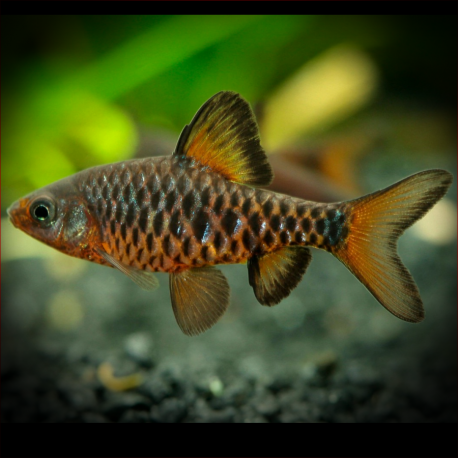More info
Datasheet
| Minimum Tank Size | 70 litres / 18.49 US gallons |
| Maximum Size | 4.5cm / 1.77inches |
| Temperature | 18°C / 64.40°F - 25°C / 77.00°F |
| Hardness | 2.02dgH / 36ppm - 12.05dgH / 215ppm |
| pH | 5.5-7.5 |
General Description
The Checkered Barb, scientifically known as Oliotius Oligolepis, is a commonly traded species in the aquarium industry, also recognized as 'checker barb,' 'checkerboard barb,' or 'island barb.' Originating from western central Sumatra, Indonesia, this fish was previously classified within the Puntius genus but has found a placement in the Oliotius genus due to its distinct physical characteristics, including unique markings and scale patterns. This species belongs to the Cyprinidae family and reaches a maximum size of approximately 4.5cm.
Aquarium Setup
The Checkered Barb thrives in a community aquarium environment and displays a peaceful demeanor. Being naturally inclined to school, it is recommended to keep a group of 6-10 individuals to ensure their comfort and visual appeal. The presence of conspecific rivals within the group enhances the males' coloration. A tank size of a minimum of 70 liters with appropriate decorations such as floating plants and driftwood is advisable. The water conditions should ideally range from a pH of 5.5-7.5, hardness of 36-215ppm, and a temperature of 18-25°C (see table).
Behaviour
Known for its peaceful nature, the Checkered Barb is an excellent addition to community tanks. Its schooling behavior is a prominent characteristic, and maintaining them in sufficient numbers reduces skittishness and enhances the aesthetic quality of the aquarium. Male Checkered Barbs tend to develop more vivid colors when in the presence of rival males.
Feeding and Diet
The Checkered Barb is considered an omnivore, primarily feeding on aquatic invertebrates, plant matter, and organic detritus in its natural habitat. In captivity, they readily accept a diet of small live and frozen foods like bloodworms, Daphnia, and Artemia, in addition to high-quality dried flakes and granules. Regular feeding ensures optimal health and vibrant coloration.
Reproduction & Dimorphism
Reproducing through egg-scattering without any parental care, the Checkered Barb spawns frequently in favorable conditions. To encourage controlled breeding, a separate breeding aquarium with appropriate substrate and low lighting is recommended. Adult males are distinguishable by their smaller size, slimmer physique, and more vibrant colors compared to females, with the color disparity being more pronounced during breeding periods.
Habitat and Distribution
Endemic to western central Sumatra, Indonesia, the Checkered Barb's distribution is primarily observed in the lower basins of rivers such as Aek Sibundung, Aek Sumuran, and Aek Garoga. Although specifics on their range remain unclear, these barbs are predominantly found in the North Sumatra province, with habitats like the Batang Gadis drainage possibly marking the northern extent of their distribution.

